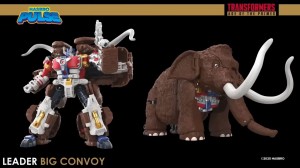Bumblethumper wrote:There's a lot of liberties taken with the science on the show. I don't think it really matters all that much. Like I heard of the La Brea Tarpits, but I never heard of any dinosaurs found in tar. Also I'd like to think we won't be still dependent on fossil fuels 50 years in the future, but who can say. It made sense for the show, and that's the main thing.
There have been finds with mass numbers of one type of fossil, leading some paleontologists to believe that animals died in a "predator trap" similar to a tar pit (though not exactly tar).
Bumblethumper wrote:Thunderscream wrote:Omega Charge wrote:I suppose there is more evidence supporting the scavenger theory...
I'm no paleontologist or biologist, but I still don't subscribe to the idea that Tyrannosaurus was purely a scavenger.
No one really believes T.rex was an exclusive scavenger. Not even paleontologist Jack Horner ... and it's his theory. I read his T.rex book. He points out the reasons why it might have scavenged: good sense of smell, small arms, the serration on the teeth.
While I don't argue that it
did scavenge, and again I don't claim knowledge in zoology, but I think there some issues to be taken with his reasoning.
Good Sense of SmellYes, tyrannosaurus had quite the honker, and a brain with a large portion dedicated to smell. But so do a lot of modern predators, including one of the dinosaurs' closest relatives, the crocodillians. Horner often sites the turkey vulture as modern example, but the turkey vulture is one of two unique (New World) vultures with a superb sense of smell. Most vultures (and birds in general) have a very poor sense of smell. And lot of terrestrial animals (primates excluded) have an excellent sense of smell, herbivore and carnivore, and they use it for more than finding their next meal.
 Small Arms
Small ArmsA lot of attention has gone into Tyrannosaurus' puny arms, but there are several examples of predators that don't use their arms to restrain prey. The crocodilians, for example, use only their jaws to grab and drag prey - and Nile crocodiles can haul in some pretty large prey.
Serrated TeethTyrannosaurs weren't unique in this feature; most predatory dinosaurs had serrated teeth, and some modern carnivoruous lizards, like the monitors, do as well. What made Tyrannosaurs unique was that the
strength of their jaws, which is theorized to have crushed bone. Horner often sites this as another example of scavenging, siting another famous "scavenger," the hyena. But spotted hyenas can and do hunt their own food, and the related aardwolf and striped hyenas can be considered as much opportunistic generalists as scavengers. In fact, the true scavengers, the vultures, have, with a few exceptions, relatively
weak jaws. Predators, again with a few exceptions, are usually the animals with powerful jaws, because they have to be able to hold and/or kill their prey with them - in the case of most cat species, that's *the* primary killing tool. If we could measure the bite strength of a T-rex, we'd probably find that it was closer to - if not superior than - those of it's living relatives, the crocodiles.
And I've gone completely off course of the main discussion










 [ Click to attempt signal recovery... ]
[ Click to attempt signal recovery... ]





































